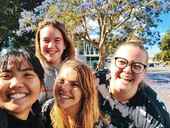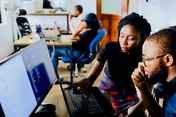Respecting diversity
Data - its collection, sense-making and use - is not neutral. Data related decisions are subject to human bias and power differences. But there are measures to help ensure this survey is equity-advancing, rights-based and participatory. Engaging diverse communities in survey planning is necessary to build trust, transparency and respect that will help connect data to the communities you serve, promote equity goals and ensure that no harm is done in the collection or use of data. Harm may fall to individuals (e.g., through bias or exclusion in survey demographic questions or failure to protect privacy) and to groups and interests (e.g., by misrepresenting data findings out of context or reinforcing stereotypes). Many First Nations, Inuit, Métis, racialized and disabled young people, youth in care and youth without citizenship status experience inequities in the fulfillment of their rights and well-being. Discrimination and inequity also affect young people along gender, language, geographic and other dimensions, often intersecting. Data collection and use can help identify and close equity gaps. However, these groups have also experienced violations of their rights in relation to the definition, collection and use of population-level statistical data. People with less privilege often have less control over data collection and use. Young people as a group are often excluded from decisions about what data will be collected about their lives and how it is collected and used.
Children and youth have rights to participate in decisions affecting them. Indigenous peoples have sovereign rights to own, control, access and possess their data (the OCAP Principles®). More information is available from the First Nations Information Governance Centre to help guide respect for these rights and principles.
The Community Child and Youth Well-being Survey is aligned with the Canadian Index of Child and Youth Well-being, a framework based on children’s universal human rights and a vision of child and youth well-being informed by many diverse people and perspectives across Canada. No single framework can encompass individual and community concepts of child and youth well-being. To help ensure that the Community Child and Youth Well-being Survey respects, protects and fulfills the rights of diverse peoples, the community can seek the leadership and participation of diverse community groups in all stages of the data cycle.
- Planning the survey
Every community is diverse in ages, cultures and the dimensions of human rights that are often associated with inequities, including ethnicity, language, migration status, religion, disability, gender, gender identity, sexual orientation and socioeconomic status.
Strategies to create opportunities for respect, inclusion and equity from the beginning of the cycle include:
- Understand how diverse your community is, considering existing leaders and tables where diversity is a part of community processes and where it is not.
- Invite diverse community leaders and representatives – including young people – to planning discussions from the start, creating a safe space to begin with key questions, concerns, rights, needs and aspirations.
- Intentionally invite interested community leaders and voices to co-design and participate in the survey Steering Committee and/or the parts of the process they choose.
- Collecting the data
In some data instruments, the indicators may be biased or irrelevant for some cultures and communities. In data collection, Indigenous communities are often excluded, and some minority populations may be unreached or unidentified so that inequities are masked. Mistrust of data collection may dissuade some people from participating.
Strategies to foster safety and respect during the data collection phase include:
- Select the optional module questions for the survey that are most relevant to diverse young people.
- Guided by the community, choose and further develop demographic identifier questions that are relevant to the diversity within the community. Where possible, draw on community or regional guides, such as Ontario’s Data Standards for the Identification and Monitoring of Systemic Racism, which informed the base demographic questions in the Community Child and Youth Well-being Survey.
- Do not report disaggregated data for specific indicators for specific communities (based on demographic identifiers) if these communities advise that they have the potential to be misused.
- Provide information about the survey, including Consent and Information Release Forms, in different languages.
- Engage diverse young people in deciding the tactics to inform and engage youth and their communities, including the purpose and use of the survey.
- Understanding the data
Understanding and communicating data involve rights that can be advanced and risks that can be mitigated with the participation of diverse young people and communities. Rights include access to data by the young people who participated in the survey. Risks include failing to reveal inequities for specific groups of people within community averages, misunderstanding data if certain groups are presented inappropriately as responsible for the inequitable outcomes they experience, and violating the privacy of young people if sample sizes are small, among others.
Strategies to address these rights and risks during data interpretation and communication stage include:
- Disaggregate data to identify the experiences of specific demographic groups only when sample sizes enable privacy protection. It may be necessary to combine small sample subgroups (e.g., neighbourhoods, non-binary genders) to achieve disaggregated insights while protecting their privacy.
- Disaggregate data to identify differences and possible inequities between groups unless the identified communities have concerns about how the data might be interpreted and used.
- Recognize that even within clearly identified groups in the community based on location or demographics, variations still exist among group members.
- Provide every opportunity for specific groups identified in the data to decide how to interpret and use (or not use) the data about them.
- Consider any modifications to the Data Sharing Agreement (see Appendix) necessary to respect the OCAP Principles and/or other community protocols.
- To the extent possible, make the survey results known in the community so that the young people who completed the survey enjoy their right to the information it generates and to the accountability we have to make the information available.
- Acting on the data
Inviting the participation of diverse community members, particularly young people, to interpret and understand the survey data is a prelude to acting appropriately on it to close equity gaps and improve young lives. The community has a responsibility to young people to take actions in response to the survey findings. To avoid misuse of data and potential harms to young people, they should be involved in deciding these actions.
Strategies to ensure the data cycle is completed while respecting rights and mitigating risks related to action include:
- Involve diverse young people in action planning.
- Bring a diversity lens to action planning, to ensure that benefits are equitably distributed and harms are avoided.
- Ensure accountability by reporting back on actions taken and their impacts on diverse young people.





































